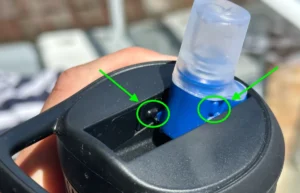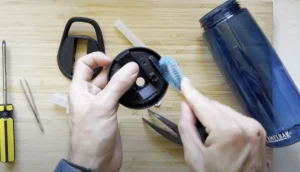I’ve been using a CamelBak for years and thought nothing of it. But when my kids started tagging along with me on my hikes and needed their own CamelBaks, it made me wonder how safe they actually were to drink from.
Especially when they told me about the plasticky taste coming from their new CamelBaks.
Because CamelBaks are treated to inhibit the growth of bacteria and are completely free of BPA, BPS, and BPF, they’re very safe to drink from. It’s still important to properly clean and dry your reservoir regularly to prevent mold from growing and to avoid using it for hot beverages or letting water sit in it for longer than is needed to prevent chemicals from leaching.
As long as you properly maintain your bladder, regularly check for mold, and practice good water safety habits, you have nothing to worry about.
Drinking from a CamelBak is perfectly safe.
Water Safety

CamelBak bladders are made of Thermoplastic Polyurethane, or TPU for short, a rubbery plastic known for its elasticity, durability, and low weight. And, best yet, for being completely free of BPA, BPS, and BPF.
TPU is known for leaving a bit of a plasticky taste in drinks and this is considered normal, especially when your CamelBak is brand new. Washing it thoroughly and even treating it with some lemon water can be a great way to clean your CamelBak and get rid of the plasticky taste or bad smells.
Although TPU is currently considered about as safe to drink from as any plastic could be, there is some evidence that there are other compounds found in plastics that may be just as unsafe as BPA — we just aren’t aware of them yet.
I’m still perfectly comfortable using my CamelBak, there are just a couple of things that I do to minimize the risk.
Don’t Use A CamelBak For Hot Drinks
High temperatures have been found to increase the rate at which chemicals leach from plastic.
This means you shouldn’t use your CamelBak (or any other plastic container for that matter) with hot or boiling water.
You should also make sure you’re not exposing your pack to the sun all day with no protection, allowing it to heat up unnecessarily.
Take the proper steps to keep the water in your CamelBak nice and cold if you’re planning on a long hike or bike ride. It’ll taste better anyway.
But, if you do happen to let the water in your reservoir heat up, just give it a thorough wash before using it again. There won’t be any long term harm done to your bladder and washing will rinse away any chemicals that did manage to leach into your water.
Don’t Let Your Water Sit Any Longer Than It Needs To
The longer you let water sit in your CamelBak, the more time chemicals have to leach from the plastic.
While CamelBak bladders are considered BPA, BPS and BPF free I personally like to be on the safe side. “Better safe than sorry” is my motto.
It’s a good habit to fill your bladder shortly before use and to empty (and rinse or wash) it as soon as you’re done.
While you’re probably okay either way, there’s no reason to risk it. You’ll avoid that plasticky taste that CamelBaks can give water after sitting for too long as well.
Watch For Mold
Aside from concerns about whether or not plastic is safe to drink from, the growth of mold in CamelBak reservoirs is a commonly overlooked issue.
In fact, I would personally say that improper cleaning and drying/storage of CamelBak bladders poses the biggest risk of drinking from them due to the potential growth of harmful mold.
CamelBak bladders are a lot harder to clean thoroughly and dry completely than water bottles — making them more susceptible to the growth of mold and mildew.
Black mold in particular is concerning, both because it’s one of the most common types of mold to grow in reservoirs and because it can make you pretty sick.
But the good news is, mold is pretty easy to prevent.
Regularly cleaning your CamelBak and drying it thoroughly are more than enough to make it a non-issue in most cases. If you’re unable to let your bladder dry completely, you can always store it in the freezer, since most mold won’t grow in temperatures below 40°F.
And if you do happen to find mold growing in your reservoir, it’s not that difficult to remove anyway. Vinegar is a great natural mold killer and soaking your reservoir and drinking tubes in a mixtures of 50% vinegar and 50% water for 30-60 minutes (or overnight) is a great way to kill most mold.
If you suspect mold in your CamelBak don’t use it again until you’re sure it’s gone.
Prevent The Growth Of Bacteria
CamelBaks are treated with HydroGuard technology, a treatment that slows the growth of harmful bacteria in your bladder.
But that doesn’t mean it’s okay to skip washes or do a lazy job. CamelBak bladders have plenty of small spaces where bacteria can multiply if left unchecked and the HydroGuard technology is preventative, but it isn't fool proof.
A CamelBak cleaning kit comes with everything you need to thoroughly sanitize every nook and cranny of your bladder — a soft brush for the reservoir, a tube cleaning brush for the hose, a couple cleaning tablets for those hard to reach places, and a reservoir hanger (fully drying your bladder is just as important as washing it well).
Features a large brush for the reservoir and a extra long straw brush to clean the drinking tube plus CamelBak cleaning tabs which will help clean away any scum. After cleaning use the reservoir drying kit to easily hang your bladder and get it completely dry.
A must have for CamelBak bladder owners.
I’d also recommend grabbing a few extra packs of CamelBak cleaning tabs (or one of these other great CamelBak cleaning tablet options), since the cleaning kit only comes with two.
Wash your bladder after every use ideally, or if you’re only using it for water, after every couple of uses.

